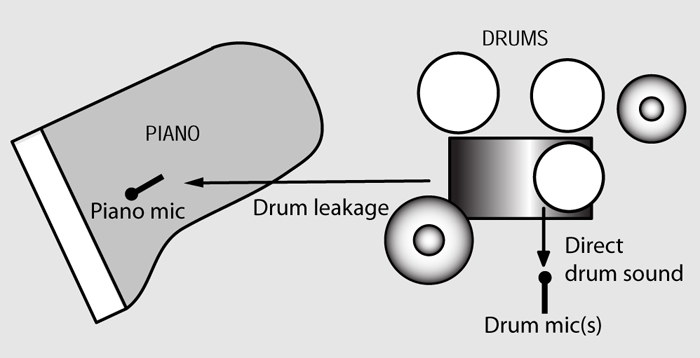Suppose you’re recording a jazz session, close-miking a drum kit and a piano at the same time (Figure 1, below).
When soloing the drum mics, you hear a close, clear sound. But when you mix in the piano mic, that nice, tight drum sound degrades into a distant, muddy sound.
The problem is happening because the drum sound leaked into the piano mic, which picked up a distant drum sound from across the room. It’s as if the piano mic has become a “room mic” for the drum kit.

To keep the recorded sound tight and/or upfront, it’s important to reduce leakage—to increase the isolation between microphones. There are several methods to do it, but how well do they work? Let’s find out with help from several audio samples. The results may be enlightening.
Problems Created By Leakage
Leakage (also called “bleed” or “spill”) is the overlap of an instrument’s sound into another instrument’s microphone. It’s unwanted sound from instruments other than the one at which the mic is aimed. For example, the piano mic also “hears” the drums; the acoustic guitar mic also hears the vocal, and so on.
This makes it difficult to control the mix. Turn up the piano mic, the drums come up as well, and they start to sound “off-mike.” Or, turn up the guitar mic, the vocal also comes up, and it sounds strange due to comb filtering – the phase interference between two mics picking up the same source at different distances.
Another problem caused by leakage is off-axis coloration. While a microphone may have a flat response on-axis (in front), it may have a non-flat response to sounds arriving from behind it. The result can be an ugly, filtered sound when the leakage mics are turned up.
In addition, leakage can create “ghost tracks.” Suppose you have a cymbal track with some electric-guitar leakage on it. Solo the cymbal track, and you hear the guitar solo faintly in the background. Punch in a correction on the guitar-solo track and play back the mix, and you might hear some of the previous solo. That’s a ghost track.
Controlling Leakage
Fortunately, there are many ways to keep leakage under control:
• Mike each instrument closely. That way the sound level at each mic is high. Then you can turn down the mixer gain of each mic, which reduces leakage at the same time. (Don’t mike too close because the tone becomes unnatural). Also, close miking with directional mics creates a bass boost called the proximity effect. When you roll off the lows to compensate, that reduces low-frequency leakage as well.
• Overdub each instrument one at a time. No leakage at all. Total isolation of tracks.
• Record loud instruments first, then quiet instruments. Leakage becomes a problem when you record loud instruments and quiet instruments at the same time. Since the quiet instruments’ mics require a lot of gain, they can pick up serious leakage from their loud neighbors. So you might record the rhythm section first (drums, bass, electric guitars and keyboards), then overdub the acoustic guitar, solos, vocals, etc.
• Record direct. For example, record an acoustic guitar from its pickup during tracking, then overdub the guitar with a mic. Record an electric guitar from its pickup during tracking, then play the guitar track through a guitar-amp plug-in during mixdown. Or record a guitar-amp emulator such as the Line 6 POD. Record a bass direct, and monitor its sound with headphones—don’t use a bass amp.
• Filter out frequencies above and below the range of each instrument. Use a high-pass filter on all tracks (except the kick and bass) to reduce low-frequency leakage.
• Use directional mics (cardioid, etc.) instead of omni mics. To increase isolation, aim the “dead” rear of cardioid mics at nearby instruments that you don’t want to pick up. An omnidirectional mic lacks this discrimination. To compensate, you have to mike closer with an omni. Clip-on omni mics can have very good isolation because they’re so close to their instruments.
• Record in a large, fairly dead studio. In such a room, leakage reflected from the walls is weak.
• Put portable walls (gobos) between instruments or use an isolation booth. A massive gobo has transmission loss: it reduces the energy of sound passing through it, which softens any leakage. Low frequencies still diffract around the top of the gobo. The taller the gobo, the lower the frequency at which it attenuates sound. Under each gobo, avoid openings because they leak sound easily. You can use a piano lid as a gobo: aim the open end away from the drums, or close the lid and cover it with moving blankets.
• Use noise gates on drum tracks. That way, leakage occurs only for a short time when a drum is struck.
Sometimes a little leakage is a good thing. It can add a sense of “air” or ambience, giving a live feel to recordings of a big band, for instance.
Examples
We can hear the effects of leakage in a controlled experiment. I set up a drum kit in my studio and miked it overhead with a cardioid, large-diaphragm condenser mic at chin height. I’ll call that the “drum mic.” I also placed a Shure SM57 several feet away, aiming away from the kit, as if it were picking up another instrument. I’ll call that the “leakage mic.”
Figure 2. below, shows the overhead drum mic, plus the leakage mic at 5 feet from the drum mic. In another test I placed the leakage mic 10 feet from the drum mic. The drum mic and leakage mic were recorded on separate tracks and mixed in various ways to create the audio samples you’ll be hearing.
Depending on studio acoustics and mic choice, your results may vary.




















